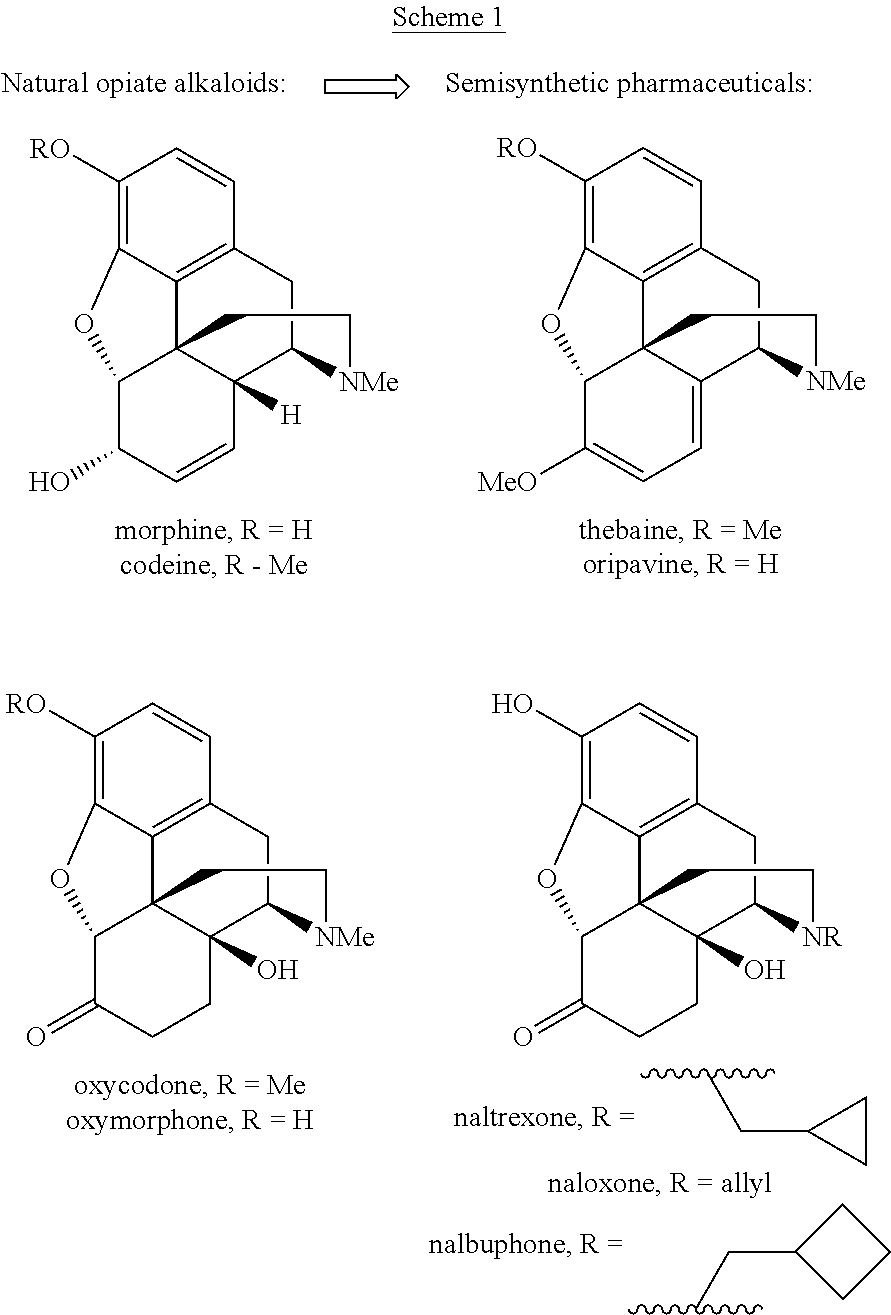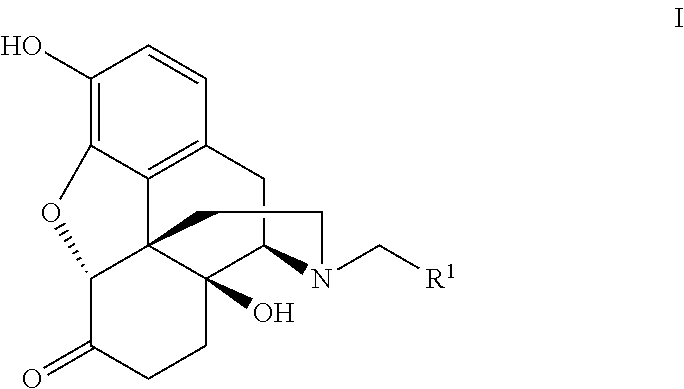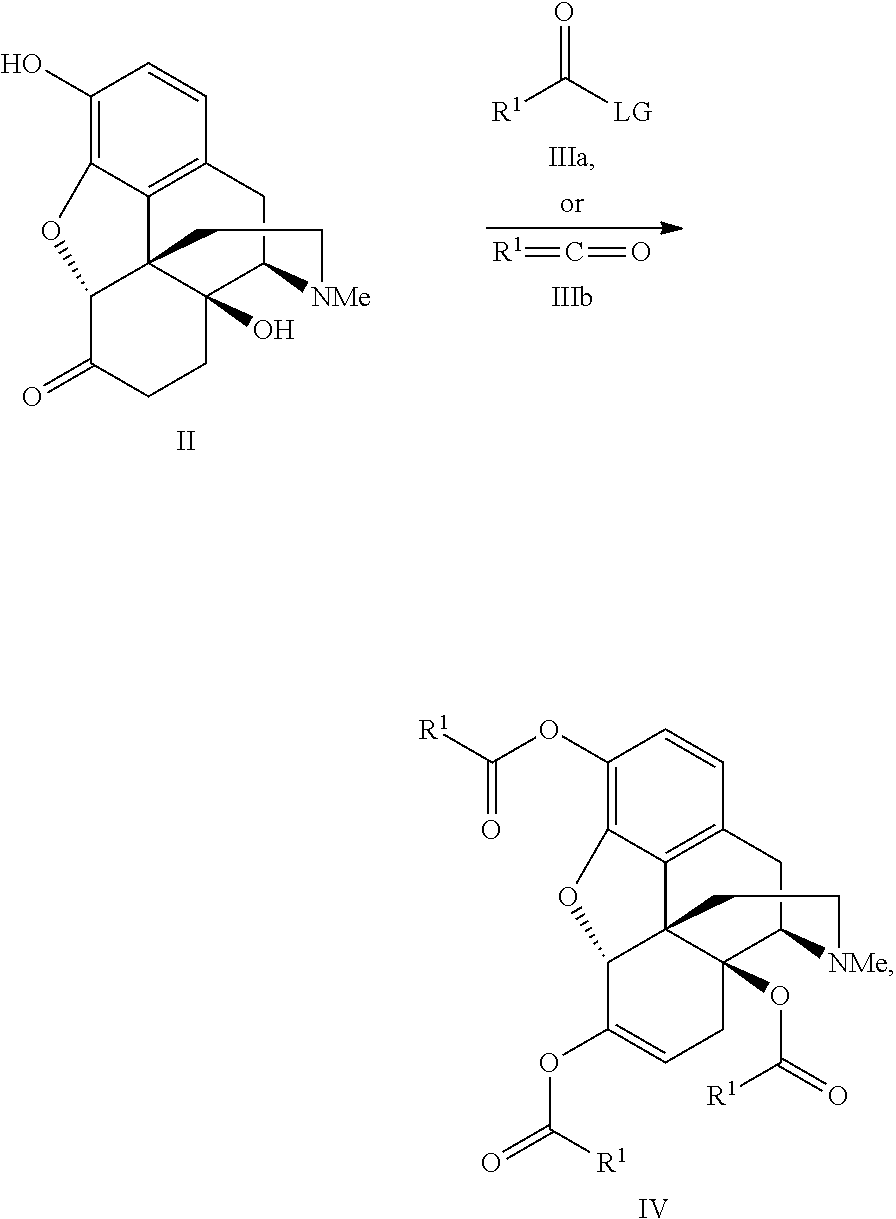Process for the preparation of morphine analogs via metal catalyzed n-demethylation/functionalization and intramolecular group transfer
- Summary
- Abstract
- Description
- Claims
- Application Information
AI Technical Summary
Benefits of technology
Problems solved by technology
Method used
Image
Examples
example 1
3,14-Diacetyloxymorphone
[0085]
[0086]A suspension of oxymorphone (3.20 g; 10.63 mmol), acetic anhydride (8.68 g; 85.04 mmol) and toluene (30 mL) was placed into a pre-heated oil bath at 80° C. After 15 mins of stirring all solid dissolved and the pale yellow solution was stirred at 80° C. for 1 h, after which time it was allowed to stir overnight at room temperature. The excess anhydride was removed by azeotropic distillation with toluene and the mixture was concentrated to a thick slurry, which was dissolved in dichloromethane. This solution was washed with sat. NaHCO3 (10 mL) and the aqueous layer was extracted with dichloromethane. (3×5 mL). Combined organic layers were washed with water, brine, dried over Na2SO4 and concentrated. Crystallization from EtOH (12 mL) and MeOH (3 mL) afforded 3.48 g of product. The mother liquor was concentrated and chromatographed (eluent EtOAc+10% MeOH). Crystallization of collected material afforded additional 0.27 g of product for the overall yiel...
example 2
3,17-diacetyl-noroxymorphone
[0088]
[0089]A mixture of 3,14-diacetyloxymorphone (Example 1, 1.0 g; 2.594 mmol), Pd(OAc)2 (0.011 g; 0.052 mmol) and dioxane (10 mL) was stirred at 80° C. under oxygen atmosphere for two days. When the TLC analysis showed that the starting material disappeared, the mixture was concentrated to a thick oil and loaded onto a chromatography column. Chromatography (eluent EtOAc+10% MeOH) afforded 0.89 g (92%) of white solid as a 1:4 mixture of the title compound; mp>235° C. (EtOH); Rf 0.32 (ethyl acetate+10% methanol; IR (CHCl3) v 3364, 3025, 3009, 2957, 2933, 1762, 1728, 1622, 1443, 1370, 1156, 1036 cm−1;
[0090]Major isomer. 1H NMR (600 MHz, CDCl3) δ 6.90 (d, J=8.2 Hz, 1H), 6.75 (d, J=8.2 Hz, 1H), 5.10 (d, J=5.9 Hz, 1H), 4.73 (s, 1H), 4.35 (s, 1H), 3.66 (dd, J=14.0, 4.8 Hz, 1H), 3.15-3.04 (m, 3H), 2.88 (d, J=18.7 Hz, 1H), 2.63 (ddd, J=12.6, 12.6, 5.2 Hz, 1H), 2.33 (s, 3H), 2.30 (m, 1H), 2.16 (s, 3H), 2.02 (m, 1H), 1.70 (ddd, J=14.0, 14.0, 3.4 Hz, 1H), 1.58 (dd...
example 3
3,6,14-Tris(cyclopropylcarboxy)oxymorphone
[0093]
[0094]A suspension of oxymorphone (1.56 g; 5.19 mmol), cyclopropylcarboxylic acid anhydride (4.0 g; 25.95 mmol), and toluene (20 mL) was stirred at 80° C. for 160 min. Then DABCO was added in one portion (1.16 g; 10.38 mmol) and the resulting mixture was stirred at 80° C. over 15 h. After this time the conversion was incomplete and an additional amount of anhydride (1.60 g; 10.38 mmol) was added and mixture was stirred at 80° C. for 5 h. Then the reaction mixture was allowed to cool down, concentrated in vacuo, and the excess anhydride was removed under high vacuum. The mixture was diluted with dichloromethane (20 mL), washed with sat. NaHCO3 (5 mL) and the aqueous layer was extracted with dichloromethane (3×5 mL). Combined organic layers were washed with water, brine, dried over Na2SO4 and concentrated. Column chromatography (eluent EtOAc→EtOAc+10% MeOH) afforded 2.37 g (90%) of the title compound as a white solid.
[0095]This reaction ...
PUM
 Login to View More
Login to View More Abstract
Description
Claims
Application Information
 Login to View More
Login to View More - R&D
- Intellectual Property
- Life Sciences
- Materials
- Tech Scout
- Unparalleled Data Quality
- Higher Quality Content
- 60% Fewer Hallucinations
Browse by: Latest US Patents, China's latest patents, Technical Efficacy Thesaurus, Application Domain, Technology Topic, Popular Technical Reports.
© 2025 PatSnap. All rights reserved.Legal|Privacy policy|Modern Slavery Act Transparency Statement|Sitemap|About US| Contact US: help@patsnap.com



